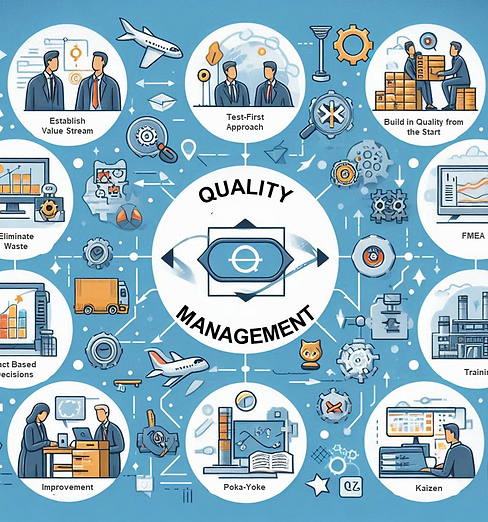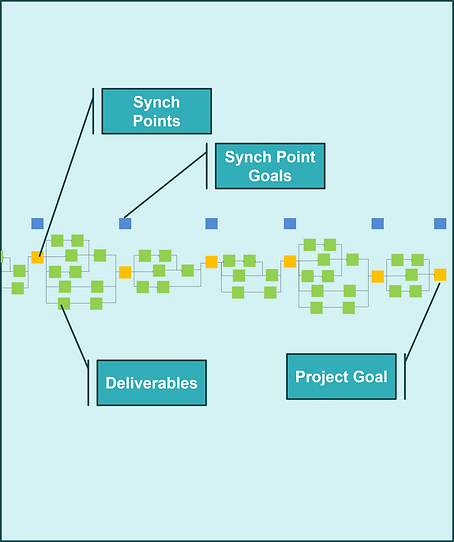Quality Management
Applying quality practices in a Lean project environment requires integrating Lean’s core principles—maximizing value, minimizing waste, and fostering continuous improvement—with proactive, built-in quality management. Here’s how you can achieve this in practice:

Key Steps to Apply Quality Practices in Lean Projects
1. Establish the Project Value Stream
-
Define the value stream from the customer’s perspective. This means understanding what the customer values and mapping all project activities to ensure each step contributes directly to that value. We do this by applying the Decentralized Planning model!
-
Eliminate waste (muda), irregularities (mura), and overburden (muri) by analyzing workflows and removing unnecessary steps or bottlenecks.
2. Build Quality In from the Start
-
Shift from reactive quality control (inspections and defect correction) to proactive quality management. This involves designing processes and products so that quality is inherent, not inspected in after the fact.
-
Use mistake-proofing (poka-yoke) and intelligent automation (jidoka) to detect and prevent defects as early as possible in the process.
3. Embed Continuous Improvement (Kaizen)
-
Foster a culture where collaboration between product development and production engineering share the responsibility for identifying and improving both the product and the production process.
-
Use frameworks like Set-Based Design to iteratively test, measure, and refine product functions for better quality outcomes.
5. Integrate Advanced Quality Tools and Technologies
-
Leverage digital tools and Quality 4.0 technologies (AI, IoT, data analytics) for real-time monitoring, predictive insights, and automated quality checks4.
-
Pilot new tools and approaches in small-scale projects before scaling for structured improvement.
Practical Examples of Lean Quality Practices
-
Test-First and Continuous Delivery: Adopt test-first approaches and continuous integration to catch defects early and maintain flow.
-
Mistake-Proofing: Use poka-yoke devices or procedures to prevent common errors in assembly or process steps.
-
Real-Time Monitoring: Deploy IoT sensors or automated dashboards to track key quality metrics and trigger immediate corrective actions.



Integrating Advanced Quality Tools i
Lean Product Development Principles
Lean Product Development (LPD) is a methodology that emphasizes maximizing customer value while minimizing waste throughout the product development lifecycle. Its core principles include:
-
Customer-Centricity: Deeply understanding customer needs and defining value from their perspective.
-
Elimination of Waste: Continuously identifying and removing non-value-adding activities.
-
Cross-Functional Collaboration: Encouraging teamwork across disciplines to foster innovation and quality.
-
Continuous Improvement: Iteratively refining processes and products through feedback and learning.
-
Knowledge Reuse: Leveraging existing knowledge and best practices to accelerate development.
These principles create a flexible, responsive environment that is well-suited for the integration of advanced quality tools.
Quality Tools: Purpose and Application
Design Failure Mode and Effects Analysis (Design-FMEA)
-
Purpose: Systematically evaluates potential failure modes in product design, their causes, and their effects on the end user.
-
Application: Conducted early and continuously in the design phase to prioritize risks and implement design improvements before costly prototypes or production runs.
Process Failure Mode and Effects Analysis (Process-FMEA)
-
Purpose: Identifies and assesses potential failures in manufacturing or assembly processes, focusing on process reliability and product consistency.
-
Application: Used during process planning to ensure robust, repeatable production with minimal defects.
Causal Loop Diagrams
-
Purpose: Causal Loop Diagrams are systems thinking tools that visualize the dynamic relationships and feedback loops between variables within a process, product, or system. They help teams understand how different factors influence each other over time, highlighting reinforcing and balancing feedback that can drive or constrain quality and performance.
-
Application: : Used in system analysis workshops and during problem solving, Causal Loop Diagrams enable teams to identify systemic causes of issues, anticipate unintended consequences, and design more robust, sustainable solutions. By mapping out cause-and-effect relationships, teams can prioritize interventions that address root causes rather than just symptoms, supporting more effective Lean improvements.
Control Plans
-
Purpose: Documents the critical process steps, control methods, and monitoring requirements to ensure consistent product quality.
-
Application: Developed alongside process planning and maintained as a living document to guide production and quality assurance teams.


Best Practices for Implementing Quality Tools in a Lean Environment
1. Early and Collaborative Risk Assessment
-
Engage cross-functional teams—including design, manufacturing, and quality—early to conduct Design-FMEA and Process-FMEA.
-
Use collaborative workshops to ensure all perspectives are considered, reducing the risk of late-stage design or process changes.
2. Integrate Quality Tools into Lean Workflows
-
Embed FMEA activities into Lean design sprints and value stream mapping sessions.
-
Use Causality Diagrams during Kaizen events to systematically address recurring issues and eliminate root causes of waste.
3. Dynamic Control Plans
-
Develop Control Plans in parallel with process development, updating them as processes evolve.
-
Link Control Plans to key Lean metrics (e.g., first-pass yield, cycle time) to ensure alignment with continuous improvement goals.
4. Leverage Digital Solutions
-
Utilize digital platforms for real-time FMEA updates, automated data collection for Control Plans, and interactive Causality Diagrams.
-
Enable rapid feedback loops and data-driven decision-making, supporting Lean’s emphasis on flow and responsiveness.
Conclusion
To apply quality practices in a Lean project environment:
-
Focus on delivering customer value and eliminating waste.
-
Build quality into every step, not just at the end.
-
Foster a culture of continuous improvement and empower all team members to contribute.
-
Use modern tools and cross-functional collaboration to sustain and scale quality improvements.
This approach ensures that quality is not an afterthought but a core outcome of Lean project management, leading to better results, lower costs, and higher customer satisfaction